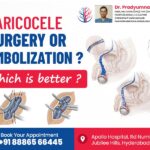Knee pain is one of the most common musculoskeletal complaints worldwide. Whether caused by overuse, osteoarthritis, or injury, it can affect quality of life. Many traditional treatment options range for knee pain, from lifestyle modification and physical therapy to medications, injections, or even joint replacement surgery.
With the advancement of technology, there are two innovative and minimally invasive treatments that are gaining attention: Genicular Artery Embolisation (GAE) and Platelet-Rich Plasma (PRP) Injection.
Although both treatments help relieve pain and improve function without major surgery, they differ in mechanism, evidence, and patient suitability. In this blog, we look at both the options.
Understanding Genicular Artery Embolization (GAE)
What is it?
Genicular Artery Embolisation, an image-guided procedure, is performed by an interventional radiologist.
This treatment involves threading a catheter into the arteries, which supply blood to the knee joint, and selectively blocking abnormal and inflamed vessels with microscopic beads or particles.
By reducing excessive blood flow, inflammation decreases, bringing relief from pain.
How it works:
Chronic knee osteoarthritis often can cause abnormal vascular growth and inflammation around the joint.
GAE targets these abnormal blood vessels and cools down the inflamed tissue.
The procedure is typically done under local anesthesia and sedation, with patients going home the same day.
Benefits of GAE:
- Minimally invasive with no surgical incision required
- Faster recovery time, and patients can resume activities within a few days
- Durable results. Many studies show that patients show pain relief lasting 1-2 years or more.
- No need for repeated injections every few months.
Limitations:
Highly skilled interventional radiologists are required for this procedure.
It is best suited for patients who have moderate to severe osteoarthritis, not for those who have acute injuries.
The treatment is not a cure, but symptoms can be managed. It does not help in regrowing cartilage.
Understanding Platelet-Rich Plasma (PRP) Injection
What is it?
Platelet-rich plasma (PRP) therapy involves taking a small sample of the patient’s blood and placing it in a special machine that separates the platelets. The platelet-rich part is then injected back into the knee. Platelets contain natural healing proteins that can help calm inflammation, ease pain, and support joint recovery.
How it works:
- The concentrated platelets release bioactive proteins and growth factors.
- These substances can reduce inflammation, support tissue repair, and may even slow down cartilage degeneration.
- The injection is usually performed in a clinic under ultrasound guidance.
Benefits of PRP:
- Uses your own blood and has a low risk of rejection or allergy
- Can be helpful for both early osteoarthritis and sports-related injuries (e.g., meniscus or ligament irritation)
- Simple outpatient procedure with no anesthesia required
- May provide longer-lasting relief than corticosteroid injections
Limitations:
- Relief is variable. Some patients feel great improvement, but others experience minimal change.
- This procedure often requires a series of injections (usually 2–3 sessions)
- Results may fade within 6–12 months, requiring repeat treatments.
GAE and PRP: Which is right for you?
Both Genicular Artery Embolisation (GAE) and Platelet-Rich Plasma (PRP) injections are innovative options for people who have severe knee pain. While both treatments aim to reduce inflammation and improve mobility without any major surgery, they work in very different ways and are best suited for different patient groups.
When PRP may be a better choice
PRP injections are often suggested for people who are in the early stages of osteoarthritis or those who have had sports-related knee injuries. In PRP, as the patient’s own blood is used, it has very little risk of allergies or rejection, making it a safe option.
PRP is best suited for patients who generally want a treatment that can:
· Reduce pain and stiffness.
· Support the healing of irritated tissues like cartilage, ligaments, or meniscus
· Delay the need for stronger treatments or surgery
However, PRP may require multiple injections to see the results and the relief from pain may only last 6-12 months before another round of treatment is required. It is best suited for patients who have milder symptoms and who don’t mind ongoing care.
Why GAE may be a good option
GAE is usually considered for patients with moderate to severe osteoarthritis who have tried other conservative options, including PRP, medications, or physical therapy, but still struggle with persistent pain. Because GAE targets the abnormal blood vessels fueling inflammation in the knee, it provides:
Longer-lasting results, often 1–2 years or more, after just one treatment
Noticeable improvement in both pain and daily function
A safe, minimally invasive alternative for people not ready or not suitable for knee replacement surgery
But GAE requires a skilled interventional radiologist and isn’t designed to regrow cartilage as it helps manage symptoms, not cure arthritis.
Conclusion
There may be no single “best” treatment for everyone. Instead, patients are asked to make the choice depending on several factors. Mild cases may largely benefit from PRP, while moderate to severe cases may do better with GAE. Younger or more active patients may prefer PRP to support joint healing, while older patients with chronic pain may benefit from GAE’s longer-lasting relief.
If you are not sure which treatment is right for you, consulting a knee specialist is the best next step. They can advise you by reviewing your medical history, imaging results, and symptoms to create a personalized plan that matches your needs.






